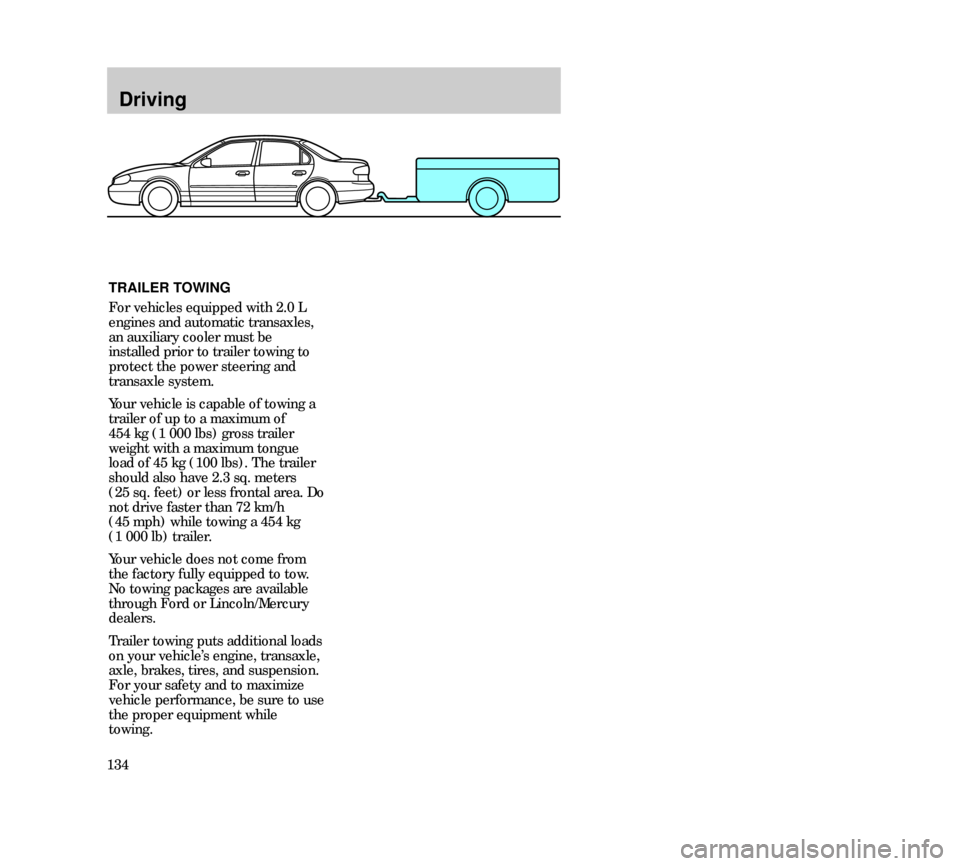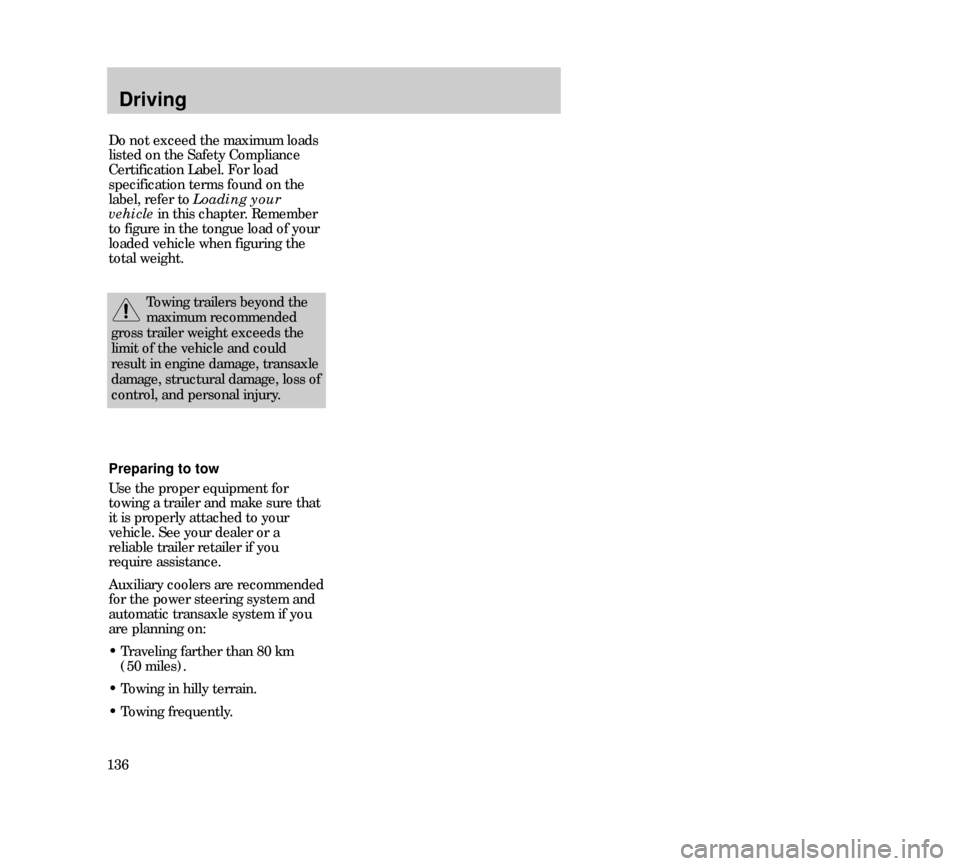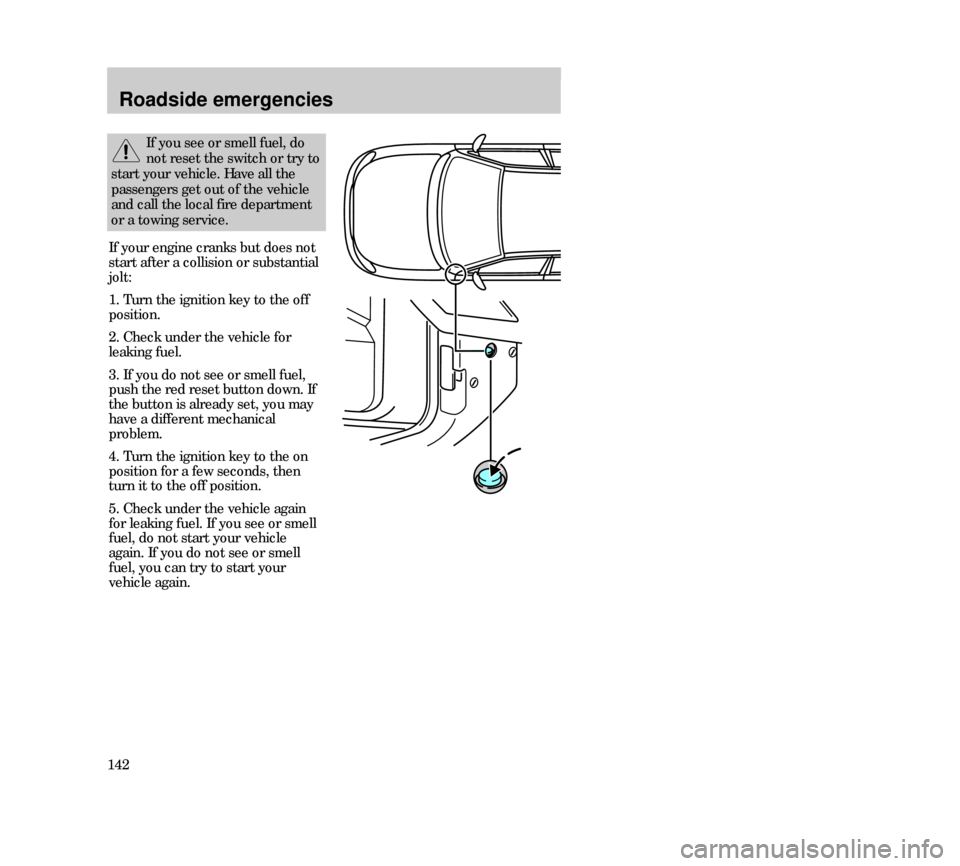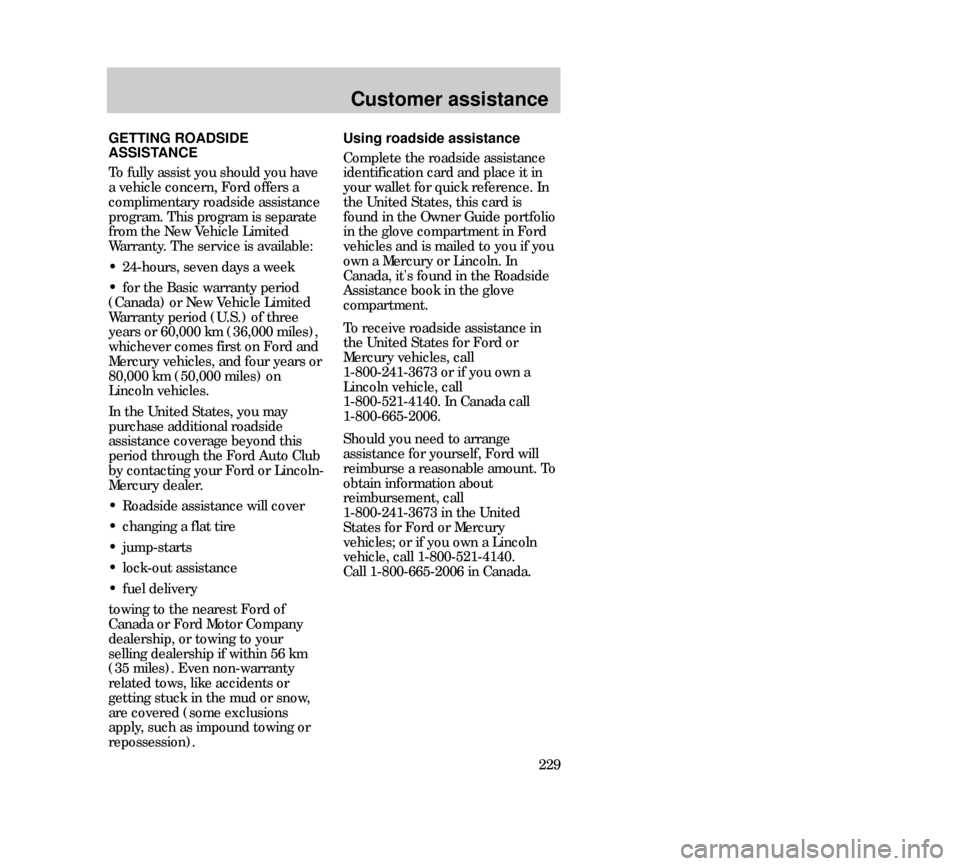tow Mercury Mystique 2000 s User Guide
[x] Cancel search | Manufacturer: MERCURY, Model Year: 2000, Model line: Mystique, Model: Mercury Mystique 2000Pages: 248, PDF Size: 2.2 MB
Page 134 of 248

Driving
134TRAILER TOWING
For vehicles equipped with 2.0 L
engines and automatic transaxles,
an auxiliary cooler must be
installed prior to trailer towing to
protect the power steering and
transaxle system.
Your vehicle is capable of towing a
trailer of up to a maximum of
454 kg (1 000 lbs) gross trailer
weight with a maximum tongue
load of 45 kg (100 lbs). The trailer
should also have 2.3 sq. meters
(25 sq. feet) or less frontal area. Do
not drive faster than 72 km/h
(45 mph) while towing a 454 kg
(1 000 lb) trailer.
Your vehicle does not come from
the factory fully equipped to tow.
No towing packages are available
through Ford or Lincoln/Mercury
dealers.
Trailer towing puts additional loads
on your vehicle’s engine, transaxle,
axle, brakes, tires, and suspension.
For your safety and to maximize
vehicle performance, be sure to use
the proper equipment while
towing.
22MDren 24.6.99 15:26 Uhr Seite 134
Page 135 of 248

Driving
135 Follow these guidelines to ensure
safe towing procedure:
• Stay within your vehicle’s load
limits.
• Thoroughly prepare your vehicle
for towing. Refer to Preparing to
towin this chapter.
• Use extra caution when driving
while trailer towing. Refer to
Driving while towing a trailerin
this chapter.
• Service your vehicle more
frequently if you tow a trailer.
Refer to the severe duty schedule
in the “Scheduled Maintenance
Guide”.
• Do not tow a trailer until your
vehicle has been driven at least
800 km (500 miles).
• Refer to the instructions
included with towing accessories
for the proper installation and
adjustment specifications.
22MDren 24.6.99 15:26 Uhr Seite 135
Page 136 of 248

Driving
136Preparing to tow
Use the proper equipment for
towing a trailer and make sure that
it is properly attached to your
vehicle. See your dealer or a
reliable trailer retailer if you
require assistance.
Auxiliary coolers are recommended
for the power steering system and
automatic transaxle system if you
are planning on:
• Traveling farther than 80 km
(50 miles).
• Towing in hilly terrain.
• Towing frequently.
Towing trailers beyond the
maximum recommended
gross trailer weight exceeds the
limit of the vehicle and could
result in engine damage, transaxle
damage, structural damage, loss of
control, and personal injury.
Do not exceed the maximum loads
listed on the Safety Compliance
Certification Label. For load
specification terms found on the
label, refer to Loading your
vehiclein this chapter. Remember
to figure in the tongue load of your
loaded vehicle when figuring the
total weight.
22MDren 24.6.99 15:26 Uhr Seite 136
Page 139 of 248

Driving
139 Driving while towing a trailer
Do not drive faster than 72 km/h
(45 mph) while towing a 454 kg
(1 000 lb) trailer. Do not drive
faster than 72 km/h (45 mph) with
any weight trailer while towing in
hilly terrain or on hot days.
Speed control (if equipped) may
not work properly while towing on
long, steep grades.
If driving with an automatic
transaxle:
• Use D (Drive) or a low gear
rather than D (Overdrive) by
depressing the TCS button on the
underside of the gearshift lever,
while towing up or down steep
inclines.
• Anticipate stops and brake
gradually.
If driving with a manual transaxle:
• Select a gear that avoids jerking
or excessive engine speed.
• Avoid driving excessively in first
or second gear. If you need to drive
excessively in first or second gear,
the trailer may be too big or too
heavily loaded for the vehicle
drivetrain.
• Shift to a lower gear while
towing up or down steep hills.
• Anticipate stops and brake
gradually.
22MDren 24.6.99 15:26 Uhr Seite 139
Page 142 of 248

Roadside emergencies
142
If your engine cranks but does not
start after a collision or substantial
jolt:
1. Turn the ignition key to the off
position.
2. Check under the vehicle for
leaking fuel.
3. If you do not see or smell fuel,
push the red reset button down. If
the button is already set, you may
have a different mechanical
problem.
4. Turn the ignition key to the on
position for a few seconds, then
turn it to the off position.
5. Check under the vehicle again
for leaking fuel. If you see or smell
fuel, do not start your vehicle
again. If you do not see or smell
fuel, you can try to start your
vehicle again.
If you see or smell fuel, do
not reset the switch or try to
start your vehicle. Have all the
passengers get out of the vehicle
and call the local fire department
or a towing service.
23MREen 24.6.99 15:28 Uhr Seite 142
Page 153 of 248

Roadside emergencies
153 Replacing a tire
1. Push the spare tire onto the
wheel studs.
2. Screw on the wheel nuts,
ensuring the tapered end of the
wheel nuts are facing the wheel,
and secure in a clockwise direction.
3. Lower the vehicle and remove
the jack by turning the handle
counterclockwise.
4. Fully tighten the wheel nuts in a
crosswise pattern.
5. Align the hub cap with the valve
and push firmly into position with
the ball of the hand.
6. Stow the jack and damaged tire
in the luggage compartment by
reversing the spare tire removal
instructions.
3
42 1
23MREen 24.6.99 15:28 Uhr Seite 153
Page 160 of 248

Roadside emergencies
160If towing is necessary, it is
recommended that your vehicle be
towed with a wheel lift or flatbed
equipment. Do not tow with
slingbelt equipment. Ford Motor
Company has not developed or
approved a T-hook or slingbelt
towing procedure. WRECKER TOWING
23MREen 24.6.99 15:28 Uhr Seite 160
Page 161 of 248

Roadside emergencies
161
Never use a tow bar that
attaches to the bumper
when you tow your vehicle. This
could damage the bumper and
cause an accident.
TOWING YOUR VEHICLE
BEHIND ANOTHER VEHICLE
Before you have your vehicle
towed:
• release the parking brake,
• move the gearshift to N
(Neutral),
• turn the ignition to the off
position and
• unlock the steering wheel.
Recreational towing or having
your vehicle towed
An example of recreational towing
would be towing your vehicle
behind a Motorhome. Follow these
guidelines if you have the need for
recreational towing.
These guidelines are designed to
ensure that your transaxle is not
damgaged.
It is not recommended to tow front
wheel drive vehicles with the front
drive wheels on the ground.
It is recommended to tow your
vehicle with the drive wheels on a
dolly or two wheel car hauling
trailer.Automatic transaxle
In case of a roadside emergency
with a disabled vehicle (without
access to wheel dollies, car hauling
trailer or flatbed transport vehicle)
your vehicle can be flat towed (all
wheels on the ground) under the
following conditions.
• Place the transaxle in N
(Neutral)
• Do not exceed a distance of
80 km (50 miles).
• Do not exceed 56 km/h (35 mph)
vehicle speed.
Manual transaxle
Do not tow your vehicle at a speed
faster than 90 km/h (55 mph). Your
maximum towing distance is
unlimited.
23MREen 24.6.99 15:28 Uhr Seite 161
Page 220 of 248

Cleaning plastic exterior parts
Use a vinyl cleaner for routine
cleaning of plastic. Clean with a tar
remover if necessary. Do not clean
plastic parts with thinners, solvents
or petroleum-based cleaners.
Cleaning the exterior lamps
Wash the exterior lamps with the
same detergent you use to wash
the exterior of your vehicle. Use
glass cleaner or tar remover if
necessary.
To avoid scratching the lamps, do
not use a dry paper towel, chemical
solvents or abrasive cleaners to
clean the lamps.
Cleaning the wiper blades
If the wiper blades do not wipe
properly, clean both the windshield
and wiper blades using undiluted
windshield wiper solution or a mild
detergent. Rinse thoroughly with
clean water. To avoid damaging the
blades, do not use fuel, kerosene,
paint thinner or other solvents.
Maintenance and care
220
31MMCen 24.6.99 15:31 Uhr Seite 220
Page 229 of 248

Customer assistance
229 GETTING ROADSIDE
ASSISTANCE
To fully assist you should you have
a vehicle concern, Ford offers a
complimentary roadside assistance
program. This program is separate
from the New Vehicle Limited
Warranty. The service is available:
• 24-hours, seven days a week
• for the Basic warranty period
(Canada) or New Vehicle Limited
Warranty period (U.S.) of three
years or 60,000 km (36,000 miles),
whichever comes first on Ford and
Mercury vehicles, and four years or
80,000 km (50,000 miles) on
Lincoln vehicles.
In the United States, you may
purchase additional roadside
assistance coverage beyond this
period through the Ford Auto Club
by contacting your Ford or Lincoln-
Mercury dealer.
• Roadside assistance will cover
• changing a flat tire
• jump-starts
• lock-out assistance
• fuel delivery
towing to the nearest Ford of
Canada or Ford Motor Company
dealership, or towing to your
selling dealership if within 56 km
(35 miles). Even non-warranty
related tows, like accidents or
getting stuck in the mud or snow,
are covered (some exclusions
apply, such as impound towing or
repossession).Using roadside assistance
Complete the roadside assistance
identification card and place it in
your wallet for quick reference. In
the United States, this card is
found in the Owner Guide portfolio
in the glove compartment in Ford
vehicles and is mailed to you if you
own a Mercury or Lincoln. In
Canada, it's found in the Roadside
Assistance book in the glove
compartment.
To receive roadside assistance in
the United States for Ford or
Mercury vehicles, call
1-800-241-3673 or if you own a
Lincoln vehicle, call
1-800-521-4140. In Canada call
1-800-665-2006.
Should you need to arrange
assistance for yourself, Ford will
reimburse a reasonable amount. To
obtain information about
reimbursement, call
1-800-241-3673 in the United
States for Ford or Mercury
vehicles; or if you own a Lincoln
vehicle, call 1-800-521-4140.
Call 1-800-665-2006 in Canada.
33MCAen 24.6.99 15:40 Uhr Seite 229